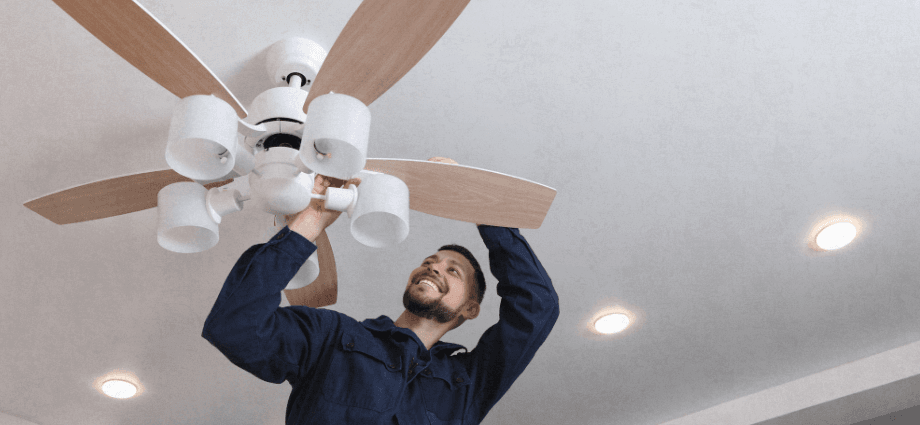Ceiling fans are more than just a decorative piece for your home—they are key to maintaining a comfortable atmosphere by improving air circulation. Whether you’re looking to enhance airflow in your living room, bedroom, or large open space, choosing the right ceiling fan can make all the difference. This guide will explore the essential features to consider when selecting a ceiling fan and highlight some of the top models known for better air circulation.
Why Ceiling Fans Are Essential for Better Air Circulation

Ceiling fans are designed to create a consistent flow of air, which helps maintain an even temperature in a room and enhances overall comfort. Here’s how they contribute to better airflow:
How Ceiling Fans Improve Airflow
The blades of a ceiling fan circulate air across the room. This movement prevents stagnant air and helps distribute cooler or warmer air evenly. When the fan runs, it pushes air downward and creates a wind-chill effect, making the room feel cooler even without a drop in temperature.
Energy Efficiency and Comfort
One of the primary advantages of ceiling fans is their energy efficiency. Unlike air conditioners that can quickly raise your electricity bill, ceiling fans use minimal power to circulate air. Running a fan during warmer months can reduce your reliance on the AC, keeping your energy costs low while maintaining comfort in your home.
Features to Look for in a Good Ceiling Fan
When choosing a ceiling fan for optimal air circulation, consider several important features to ensure efficiency and comfort in your space.
Fan Size and Blade Span
Selecting the right fan size is crucial for effective air circulation. The size of the fan should match the room size for optimal airflow. A larger room requires a fan with a bigger blade span, while smaller rooms can benefit from a more compact design.
- For small rooms (up to 75 sq. ft.), choose a fan with a 29-36 inch blade span.
- For medium-sized rooms (up to 144 sq. ft.), go for a fan with a 44-50 inch blade span.
- For larger spaces (over 225 sq. ft.), select fans with a 60-inch or larger blade span.
Motor Type and Speed Settings
The motor is the heart of any ceiling fan. Fans with DC (direct current) motors are quieter, more energy-efficient, and tend to have more speed settings compared to AC (alternating current) motor fans. Multiple speed options allow you to adjust airflow according to the temperature, ensuring you can keep the room as cool or as gentle as needed.
Design and Aesthetics
While performance is essential, the design of the fan should complement your room’s décor. Ceiling fans come in a range of styles, from modern and sleek to more traditional or vintage designs. Whether you want a minimalist fan or a statement piece, there’s a design to match every room in your home.
Top Ceiling Fans for Better Air Circulation
Now that we’ve covered what to look for in a ceiling fan, let’s explore some of the best options available for better air circulation.
Hunter Signal Ceiling Fan
Hunter is a well-known name in the ceiling fan industry, and the Signal Ceiling Fan is a top choice for its quiet motor and efficient performance. This fan is designed with a sleek, modern style that fits seamlessly into both traditional and contemporary rooms.
- Key Features: Quiet motor, reversible airflow for winter use, energy-efficient, remote control for convenience.
- Best For: Small to medium-sized rooms, bedrooms, and living spaces where noise reduction is important.
Westinghouse Lighting Comet Ceiling Fan
The Westinghouse Lighting Comet ceiling fan offers excellent airflow with its efficient motor and contemporary design. It’s a great option for those who want both performance and style at a reasonable price.
- Key Features: Powerful airflow, reversible motor, energy-efficient design, easy installation.
- Best For: Medium-sized rooms, such as living rooms or dining areas, where enhanced airflow is needed.
Emerson Carrera Grande Eco Ceiling Fan
Emerson’s Carrera Grande Eco Ceiling Fan is designed for larger rooms and open spaces. Its impressive 60-inch blade span makes it ideal for big areas, and its energy-efficient motor helps reduce electricity consumption while maintaining powerful air circulation.
- Key Features: Large blade span (60 inches), eco-friendly motor, quiet operation, stylish contemporary design.
- Best For: Large living rooms, open-plan spaces, or any area where high airflow is necessary.
Minka Aire Concept II Ceiling Fan
Minka Aire’s Concept II Ceiling Fan is the epitome of modern design. Its sleek, minimalistic look pairs well with contemporary interiors, while its quiet motor ensures smooth and efficient air circulation without disrupting the room’s atmosphere.
- Key Features: Sleek design, remote control included, whisper-quiet motor, efficient airflow.
- Best For: Modern homes, spacious rooms, and anyone who values quiet performance.
Honeywell Xerxes Ceiling Fan
Honeywell is known for producing reliable, high-performance ceiling fans, and the Xerxes model is no exception. With its modern design and energy-efficient motor, it’s a solid choice for homeowners looking for an effective and stylish fan.
- Key Features: Contemporary design, remote control, 3-speed motor, energy-efficient.
- Best For: Living rooms, bedrooms, and large spaces that require both style and performance.
Installation Tips for Optimal Air Circulation
To get the best performance from your ceiling fan, it’s crucial to install it correctly. Here are some tips to ensure optimal air circulation:
Choosing the Right Spot
The fan should be installed in the center of the room to maximize airflow. Installing the fan near a wall or corner will limit its effectiveness. Avoid placing it too close to the ceiling, as this can reduce its ability to circulate air evenly.
Proper Ceiling Height and Mounting
For effective circulation, the fan should be installed 7-9 feet above the floor. This allows the fan to distribute air evenly without obstructing movement or causing discomfort. Make sure the fan is securely mounted to avoid any safety hazards or wobbling.
Maintenance Tips to Keep Your Ceiling Fan Working Efficiently
A ceiling fan requires minimal maintenance, but keeping it clean and in good condition will ensure that it continues to circulate air effectively.
Regular Cleaning
Dust and debris can accumulate on fan blades, which can hinder airflow. Cleaning the blades every few weeks will help maintain the fan’s efficiency. Use a damp cloth to wipe the blades and prevent dirt buildup, especially in areas with a lot of dust.
Checking for Balance
If your ceiling fan starts making noise or wobbling, it might be unbalanced. Ensure the blades are level by using a blade balancing kit. An unbalanced fan can not only create noise but also put extra strain on the motor, reducing its lifespan.
Conclusion
Investing in a high-quality ceiling fan is a simple yet effective way to improve air circulation in your home. Whether you need a fan for a small bedroom or a large living room, options like the Hunter Signal, Westinghouse Comet, and Emerson Carrera Grande Eco stand out for their excellent performance and design. With the right installation and maintenance, a ceiling fan can enhance the comfort of your space while saving you money on energy bills.



